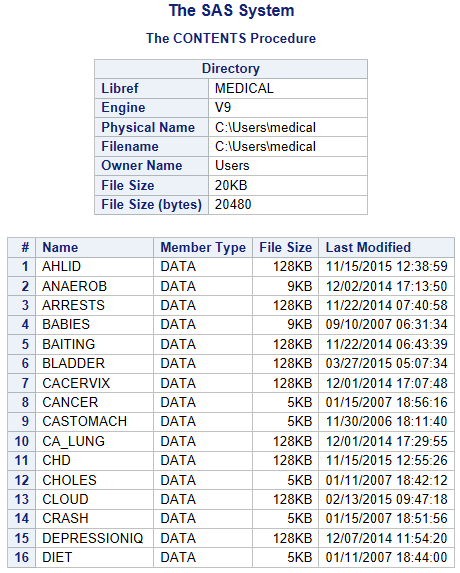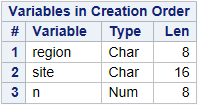Viewing SAS Libraries
Viewing Libraries
Besides
accessing library details with librefs, you can also see libraries
in other environments. You can access a brief overview on the windows
and menus of the SAS windowing environment, Enterprise Guide, and
SAS Studio at http://video.sas.com/. From Categories select How To Tutorials>Programming. Select the video for your SAS environment. Other
tutorials are available from the SAS website.
Viewing Libraries Using PROC CONTENTS
You can use the CONTENTS
procedure to create SAS output that describes either of the following:
-
the contents of a library
-
the descriptor information for an individual SAS data set
|
Syntax, PROC CONTENTS
step:
PROC CONTENTS DATA=SAS-file-specification NODS;
RUN;
|
Examples: PROC CONTENTS Output
To view the contents
of the entire clinic library, you can submit the following PROC CONTENTS
step:
proc contents data=medical._all_ nods;run;
The output from this
step lists only the names, types, sizes, and modification dates for
the SAS files in the Medical library.
Figure 3.2 PROC CONTENTS Output: the SAS Library Medical (partial output)

To view the descriptor
information for only the medical.Lesions data set, you can submit
the following PROC CONTENTS step:
proc contents data=medical.lesions; run;
The output from this
step lists information for medical.Lesions, including an alphabetic
list of the variables in the data set.
Figure 3.3 PROC CONTENTS Output: Descriptor Information

Figure 3.4 PROC CONTENTS Output: Engine/Host Dependent Information

Figure 3.5 PROC CONTENTS Output: Alphabetic List of Variables

Viewing Libraries Using PROC DATASETS
In addition to PROC CONTENTS, you
can use PROC DATASETS to view the contents of a SAS library or a
SAS data set. PROC DATASETS also enables you to perform a number of
management tasks such as copying, deleting, or modifying SAS files.
PROC CONTENTS and PROC
DATASETS overlap in terms of functionality. Generally, the following
are the same:
-
the CONTENTS procedure
-
the CONTENTS statement in the DATASETS procedure
|
PROC CONTENTS<options>;
RUN;
|
PROC DATASETS<options>;
CONTENTS<options>;
QUIT;
|
Here is the major difference
between the CONTENTS procedure and the CONTENTS statement in PROC
DATASETS:
-
The default value for libref in the DATA= option. For PROC CONTENTS, the default is either Work or User depending on your SAS solution or environment. For the CONTENTS statement, the default is the libref of the procedure input library.Note: PROC DATASETS supports RUN-group processing. It uses a QUIT statement to end the procedure.
However, the options
for the PROC CONTENTS statement and the CONTENTS statement in the
DATASETS procedure are the same. For example, the following PROC steps
produce essentially the same output (with minor formatting differences):
proc datasets; contents data=medical._all_ nods; proc contents data=medical._all_ nods; run;
Figure 3.6 PROC DATASETS Output: Directory Information

Figure 3.7 PROC DATASETS Output: Library Members (partial output)

Figure 3.8 PROC CONTENTS Output: Directory Information

Figure 3.9 PROC CONTENTS Output: Library Members (partial output)

Viewing Data Set Descriptor Information Using PROC DATASETS and the VARNUM Option
As with PROC CONTENTS, you can
also use PROC DATASETS to display the descriptor information for a
specific SAS data set.
By default, PROC CONTENTS
and PROC DATASETS list variables alphabetically. To list variable
names in the order of their logical position (or creation order) in
the data set, specify the VARNUM option in PROC CONTENTS or in the
CONTENTS statement in PROC DATASETS.
For example, either
of these programs creates output that includes the list of variables
shown below:
proc datasets; contents data=medical.Lesions varnum; proc contents data=medical.Lesions varnum; run;
Figure 3.10 Viewing Descriptor Information for a SAS Data Set Using VARNUM

Last updated: January 10, 2018
..................Content has been hidden....................
You can't read the all page of ebook, please click here login for view all page.
